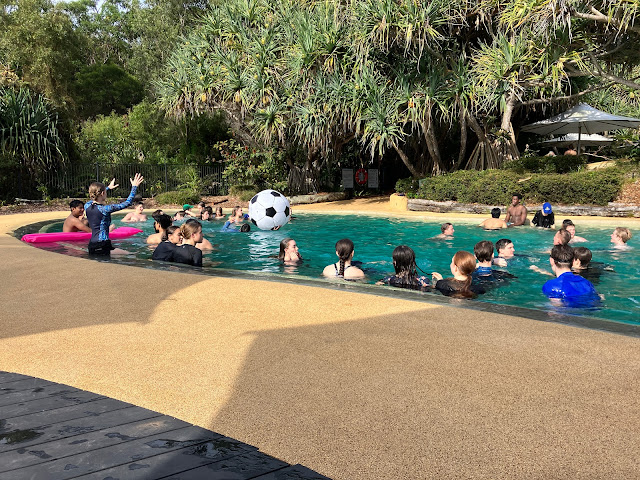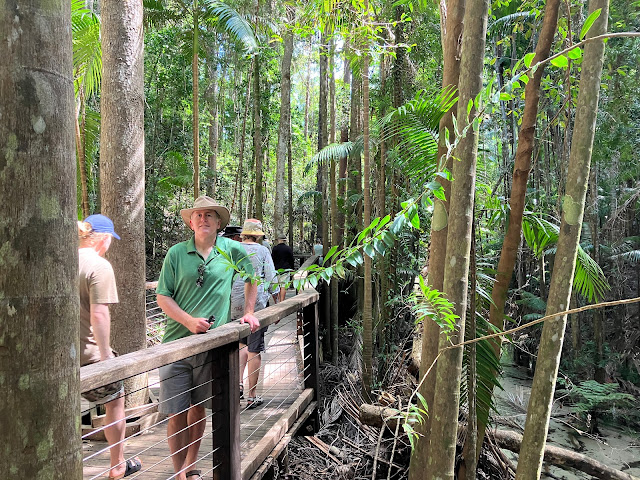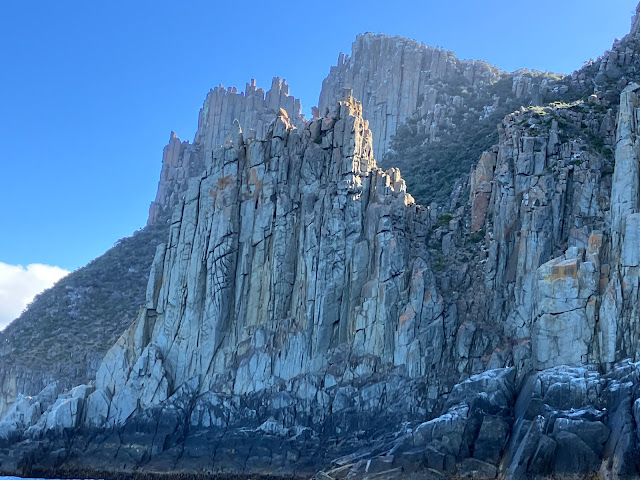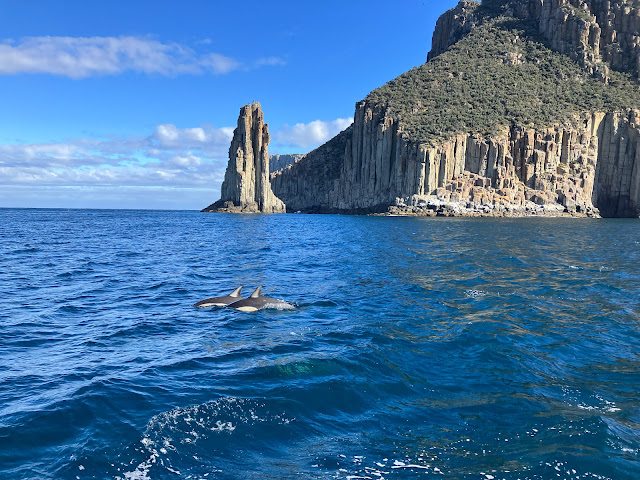For the past couple days we have been on a two-day tour of Fraser Island (K'gari). It is a large sand island just off the coast of Queensland on the edge of the Coral Sea. There is no bridge, so the only way on or off the island is via a ferry.
On the ferry over, we noticed that we were much, much older than the majority of the passengers. We were surrounded by several throngs of teens wearing "Class of 2023" shirts, chatting away, flirting with each other, snapping photos with their phones. Camping is a popular thing to do on the island, so I just figured they were all there for some sort of school camp. The group didn't come with us on the resort shuttles from the ferry dock, so I thought nothing more of it as we checked into the hotel. For the first night of our tour, we were booked into a very nice room at the Kingfisher Resort. We had a pretty view of a lily pond from our deck. It seemed like a tranquil and relaxing retreat. I had booked a massage at the day spa, and hurried off to that appointment while Kevin headed off to lounge by the pool and read.
An hour later, I left the spa and checked my phone. Kevin had texted the photo below, follwed by a series of several other similar ones. The teens -- all 97 of them, we learned after talking to one of the chaperones -- were not camping elsewhere on the island but were instead staying at the resort all week! Crikey!
Luckily we discovered that they had a set schedule, with very little free time. After a couple hours in the pool, they all mysteriously disappeared to some conference room and we didn't see them again for the rest of the night or the next morning at breakfast. I will say the pool at sunset was much more peaceful than it was just hours before.
The next morning, we packed up our bags and went off to meet our tour. The K'gari Explorer Tours are technically a "bus tour" but it was a bus unlike any other -- a huge hulking machine with enormous wheels. All the roads on the island outside the Kingfisher Resort are rough tracks through the sand. About 25 of us piled into the bus for a trip across the island to K'gari Beach Resort on the western shore.
Like the Kingfisher Resort, the staff at the K'gari Resort instructed us multiple times about the many dangers on the island. (Remember, Australia is always trying to find ways to kill you...) In addition to spiders, snakes, riptides, and other hazards, we had to be on the lookout for dingoes. In fact, dingos are the apex predator on the island. We were told that if we encountered a dingo, we should stand up tall, stay in a group, never turn your back on a dingo, and most importantly do not run away from the dingoes. Both resorts were entirely enclosed inside a "dingo-proof-fence" and we were also directed to always, always close the gate behind us if we left the enclosed compound to go on an evening stroll. Ha! Like we were going to do that, after all the warnings. Kevin joked that it all seemed eerily similar to the instructions given to visitors to Jurassic Park.
The aboriginal name for this island is K'gari (pronounced GAH-ree). After Westerners came it was renamed Fraser Island for a couple hundred years, but recently the island has become known as K'gari again. It is a UNESCO World Heritage site for several reasons - the main one being that it is the largest sand island in the world. Most sand "islands" are just rather big sandbars but K'gari is 75 miles long and about 15 miles wide, making it over 600 square miles of sand. As someone who already doesn't love the beach, I began to wonder if I had made a mistake in coming here. So. Much. Sand.
Getting anywhere on the island requires a four-wheeled-drive vehicle with high clearance that is capable of driving on sand and plowing through a couple feet of water when necessary. You can bring your own vehicle but you do so at your own risk. We wouldn't have wanted to bring a rental car here, but even more ironically our rental company "upgraded" us to a lowriding BMW 220i which is basically the opposite of all the above requirements (they'd run out of the cheapo car model we'd reserved). So we wisely left it parked back on the mainland.
The shore along the western side of the island is basically a highway. And I mean that literally. Known as "75 Mile Beach Highway" it stretches along the coast with lots of bumps, ruts, and washouts (where a freshwater stream cuts a channel across the beach to the ocean). Sand conditions can be anything from packed hard sand to soft loose sand, to anything in between. Squalls can bring the occasional downpour of driving rain. In addition to these road hazards, there are loads of other pitfalls to watch for on the road: cars coming from the other direction (it's a two-way highway -- keep to the left!), fishermen at the shoreline, tour groups milling around, tour busses making u-turns to look at stuff, dirt bikes, and the occasional dingo. Oh, and of course the posted speed limit is 80 km/h (about 50 mph). People driving their own cars or hired 4x4s who aren't familiar with how to drive in the conditions get stuck all the time, and we saw at least one tow truck whizzing by at high speed.
Did I mention that there are several sand airstrips that also share the highway?
With all of those hazards to watch out for, we were really glad to leave the driving to our experienced tour guide Warren.
You would think that being a sand island there would be no vegetation, but you'd be wrong. The interior of K'gari is a dense subtropical rainforest full of extremely tall trees. In the 1860's a logging camp was set up on the island and the result of cutting down centuries-old trees has reshaped the forest and left a lasting legacy. The main trees they were after were the "Fraser Island Turpentines" (satinay) -- the bark of this tree is impervious to marine borers (shipworms) that used to wreak havoc on the hulls of wooden sailing vessels. There are still some native hoop pines and satinay trees growing tall, but many were logged and have been replaced with non-native species. So the forest is still densely packed, but the predominant species have changed since the logging camp was here.
How do so many trees grow in pure sand? Well, the sand here is actually coated with minerals that the trees and plants use to get the required nutrients. Fungi, lichen, and rotting vegetation also provide some nutrients but there really is no soil to speak of -- the plants here are just well-adapted to growing in sandy conditions. There are also a few species of epiphyte which are plants that can grow in the air -- they get their water and nutrients from the atmosphere. In this photo you can see some staghorn ferns that look like big round green fans growing right out of the tree trunk. Those aren't part of the tree and they aren't parasitic either -- they just perch on the outside of the trunk and pull what they need to live out of thin air!
One of the activities on our tour was a grueling afternoon hike up and over an enormous sand dune (entertainingly named the "Hammerstone Sandblow") -- in scorching heat and high humidity. At the end of the sahara-like sandy stretch was Lake Wabby, the deepest lake on the island.
We much preferred another freshwater lake that had a car park, picnic tables, and zero sand dune hiking required. Lake McKenzie is a crystal-clear lake with a truly white sand beach and bottom beneath it. The lake is fed by pure rainwater, not groundwater or stream water as it sits too high above the water table. The water is so pure that it doesn't support much marine life.
There were lots of opportunities to cool off in the heat. After our inland swims on the first day, we also visited the Champagne Pools. These are tidepools where the water bubbles whenever the waves crash over the rocks.
As the tour continued we saw several signs of dingoes, but no actual dingoes. I was getting concerned because my main reason for coming to this island was specifically to see at least one wild dingo.
So the search continued...Meanwhile, we explored the wreck of the SS Maheno.
Maheno was a luxury ocean liner that ferried people in style across the Tasman Sea from the early 1900s until the first world war. During WWI it was converted to a hospital ship, and then put back into commercial service. Its main route was from New Zealand to Australian ports, although it did make a few trips further afield before being retired. It was actually in the process of being towed to Japan for parts when a cyclone hit on July 7, 1935. The tow line broke and the Maheno was beached on the western shore of Fraser Island. Subsequent efforts to re-float her were unsuccessful and she has remained on the beach, slowly deteriorating, ever since. Here's what she looked like in her prime.
It's a huge wreck, the ship was originally 400 feet long. During WWII the Australian military used it for bomb target practice, further hastening its demise.
Because of the possibility of unexploded ordinance (and the threat of tetanus from the rusting metal), you cannot walk around inside the ship. If the authorities see you, you will be fined. But the tide was low, so to get this shot Kevin stayed outside the ship but just walked around to the other side of the hull. So no rules were broken!
As we ended the second day and started driving back towards the ferry we finally saw a dingo, a juvenile male just sitting by the roadside. You might be asking, what exactly is a dingo? Dingos are a type of wild canid that originally evolved from the Asian wolf. They were partially domesticated and were eventually brought here to K'gari by members of the Butchella people (the original owners of this island) over 4000 years ago. Then over time they stopped being domesticated and became feral again. Dingoes are found throughout most of Australia, but because of the isolated location the K'gari dingoes have never interbred with other canines and are more "pure dingo" than those elsewhere.
As you would expect, there are always issues between these wild animals and humans. The dingoes are very clever, and will use pack hunting strategies to steal food from humans recreating on the island. The resorts have dingo-proof fences, but there are many campgrounds and free-camp places that are open to the wilderness -- there is always some kind of conflict when humans intrude into the wild. When tourists first started coming here, they actually fed the dingoes on purpose. Over time, the original population of 200 dingoes doubled to 400. A law was put into place that made feeding the dingoes punishable by fine. Without an easy food source, the population returned to around 200.
There have been several incidents over the years where young children have been injured and even killed by dingo maulings. The park service continues to try to educate visitors on dingo safety, and to try to limit human interactions with these wild creatures. Ranger vehicles were stopped near several of the dingoes we saw.
Each dingo is tagged and monitored by the parks service. You can see the tags in the ears -- females are tagged in the right ear, males in the left.
After three days exploring the island, we had to head back to the mainland and continue on with our trip. We can see why many Australians recommended this island as a "must-see" while here; we had a truly unique experience on K'gari!


























































